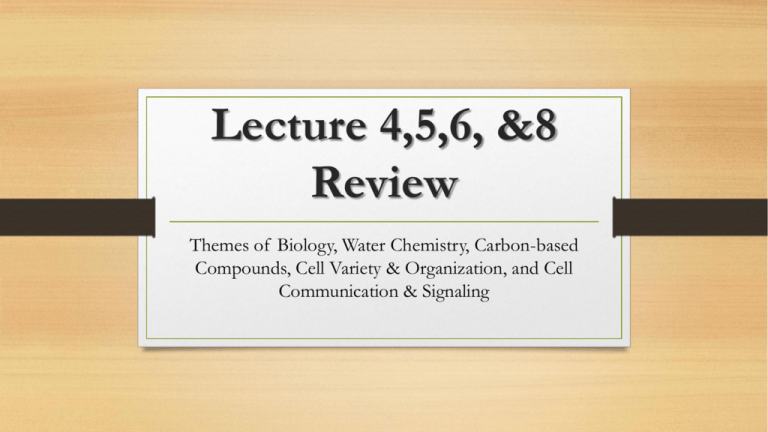Lecture 1-8 Review
advertisement

Lecture 4,5,6, &8 Review Themes of Biology, Water Chemistry, Carbon-based Compounds, Cell Variety & Organization, and Cell Communication & Signaling Agenda • Lecture 4, 5, 6, & 8 key points review. Groups of 2 have 2 minutes to summarize each key lecture point to respond to a 2 minute question/discussion. Mr. F clarifies if understanding is not complete. • Practice worksheets (answer keys put on class website under links & resources). Lecture 4 Nucleotides consist of a sugar, phosphate group, and nitrogen-containing base. Ribonucleotides polymerize to form RNA. Deoxyribonucleotides polymerize to form DNA. DNA’s primary structure consists of a sequence of nitrogen-containing bases; its secondary structure consists of two DNA strands running in opposite directions, held together by complementary base pairing, and twisted into a double helix. DNA’s structure allows organisms to store and replicate the information needed to grow and reproduce. RNA’s primary structure consists of a sequence of nitrogen-containing bases. Its secondary structure includes short regions of double helices and structures called hairpins. RNA was likely the first self-replicating molecule and a forerunner to the first life-form. Nucleic acids form when nucleotides polymerize. DNA’s secondary structure consists of two antiparallel strands twisted into a double helix. The molecule is stabilized by hydrophobic interactions in its interior and by hydrogen bonding between the complementary base pairs A-T and G-C. Like DNA, RNA has a primary structure consisting of a sugar-phosphate backbone formed by phosphodiester linkages and, extending from that backbone, a sequence of four types of nitrogenous bases. RNA can both provide a template for copying itself and catalyze the polymerization reactions that would link monomers into a copy of that template. Thus, most origin-of-life researchers propose that the first life-form was made of RNA. Know the following scientists’ contributions to DNA’ discovery: 1. Frederick Griffith 2. Avery, McCarty, MacLeod 6. Maurice Wilkins & Rosalind Franklin 7. Watson & Crick 3. Alfred Hershey & Martha Chase 8. Meselson & Stahl 4. Linus Pauling 5. Erwin Chargaff Lecture 5 Sugars and other carbohydrates are highly variable in structure. Monosaccharides are monomers that polymerize to form polymers called polysaccharides, and are joined by different types of glycosidic linkages. Carbohydrates perform a wide variety of functions in cells: serving as raw material for synthesizing other molecules, providing structural support, indicating cell identity, and storing chemical energy. Many distinct monosaccharides exist because so many aspects of their structure are variable: aldose or ketose placement of the carbonyl group, variation in carbon number, different arrangements of hydroxyl groups in space, and alternative ring forms. Each monosaccharide has a unique structure and function. Carbohydrates have diverse functions in cells: In addition to serving as precursors to larger molecules, they provide fibrous structural materials, indicate cell identity, and store chemical energy. Lecture 6 Plasma membranes are made up of selectively permeable bilayers of phospholipids. Phospholipids are amphipathic lipid molecules – they have hydrophobic and hydrophilic regions. Ions and molecules diffuse spontaneously from regions of higher concentration to regions of lower concentration. Movement of water across a plasma membrane is called osmosis. In cells, membrane proteins are responsible for the passage of insoluble substances that can’t cross the membrane on their own. Membrane-forming lipids contain both a polar, hydrophilic region and a nonpolar, hydrophobic region. Phospholipid bilayers have selective permeability. Molecules and ions move randomly when a concentration gradient exists, but there is a net movement from high- concentration regions to low-concentration regions. Diffusion along a concentration gradient increases entropy and is thus spontaneous. The selective permeability of the lipid bilayer and the specificity of the proteins involved in passive transport and active transport enable cells to create an internal environment that is much different from the external one. Lecture 8 Extracellular material strengthens cells and helps bind them together. Cell-cell connections help adjacent cells adhere. Cell-cell gaps allow adjacent cells to communicate. Intercellular signals are responsible for creating an integrated whole from many thousands of independent parts. In target cells, intercellular signals are received, processed, responded to, and deactivated. If the signal is received at the cell surface, the processing step involves production of an intracellular signal. Like the extracellular materials found in other organisms, one of the ECM’s most important functions is structural support. The presence of a middle lamella, continuous ECM, tight junctions, desmosomes, and cadherins bind adjacent cells to each other. Plasmodesmata in plants and gap junctions in animals allow adjacent cells to communicate. Identical receptors in diverse cells and tissues allow long-distance signals to coordinate the activities of cells throughout a multicellular organism. When a signal binds at the cell surface it triggers a complex series of events, collectively called a signal transduction pathway, which converts the extracellular hormone signal to an intracellular signal.




